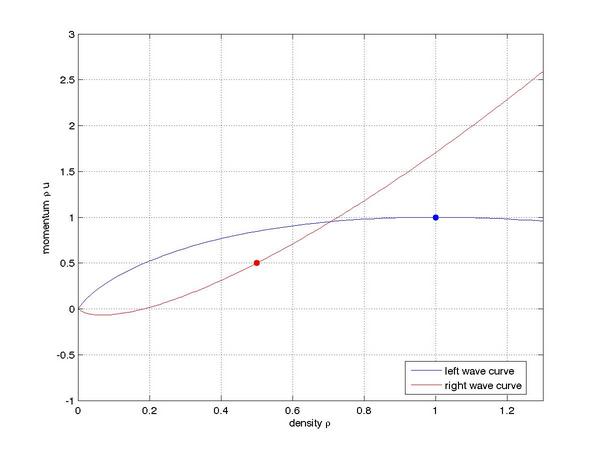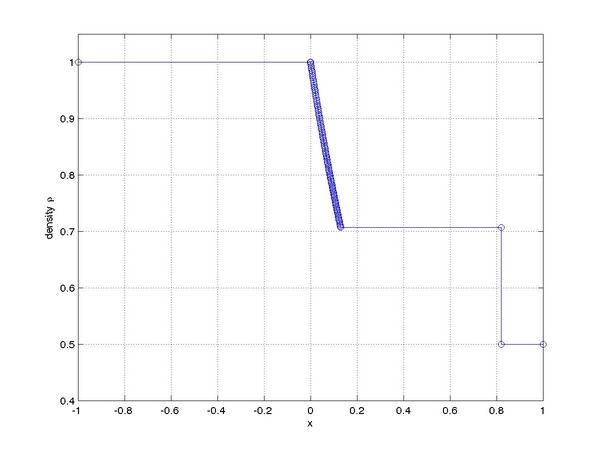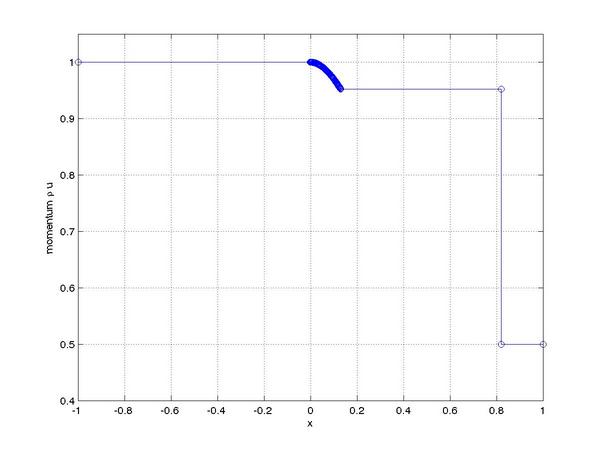A Riemann Solver For the Isothermal Equations
by John Weatherwax
Introduction
Here you'll find code in FORTRAN
implementing a Riemann solver for the Isothermal equations of gas
dynamics. The Isothermal equations arise as a simplification to
the full Euler equations of gas dynamics when one assumes that all
motion occurs at constant temperature. The resulting equations
are given by the following system
 The system above is closed in terms of the two
conservative variables
The system above is closed in terms of the two
conservative variables
 or the two primitive variables
or the two primitive variables
 A Riemann problem is the solution to the above partial
differential equations with a discontinuous initial condition
given by
A Riemann problem is the solution to the above partial
differential equations with a discontinuous initial condition
given by
 The Riemann solver itself is contained in the file "riemann.f", but a
simple driver application is compiled when one builds the package. The
driver application is called "ne.out" and reads its input from a text file
called newt.inp. In this text
file one specifies the left and right states, a Courant like number for
use in printing, and some flags that control output. In the example below
the code solves a Riemann problem with initial conditions given by
The Riemann solver itself is contained in the file "riemann.f", but a
simple driver application is compiled when one builds the package. The
driver application is called "ne.out" and reads its input from a text file
called newt.inp. In this text
file one specifies the left and right states, a Courant like number for
use in printing, and some flags that control output. In the example below
the code solves a Riemann problem with initial conditions given by
 The current flags settable in newt.inp are (they can be turned on
or off)
The current flags settable in newt.inp are (they can be turned on
or off)
- PRINT_NEWTON: Prints to the screen the initial
state and the density updates computed as the newton iterations
converge (at each timestep) as the intersection of the two wave
curves is found in the density momentum plane. Note: the
intersection of the wave curves is found by considering density
to be an independend variable and momentum the dependent
variable.
- PRINT_NEWTON_CONV: Prints the convergence steps of the
newton iterations into two files "rm_conv_l_test.dat", and
"rm_conv_r_test.dat" representing the newton iterates on each
of the two wave curves (left and right) in the density momentum
space respectively.
- PRINT_RP: Prints a summary of all the wave produced for the
specific Riemann problem to be solved. This is saved in the
file "RP_test.dat". The information includes the states between
the two waves, the wave speeds, the wave types (shock, or
rarefaction fan) and a flag variable denoting the "significance"
of the waves a boolean variable denoting a waves strengh (strong
or weak).
- PRINT_WC: Prints the left and right wave curves in the (density,momentum)
plane and the left and right Riemann invariants (in the file
iLiR_curv_{l,r}_test.dat). The ordering of the variables in the
files is given by the ordering in the filename. We define the
left and right Riemann invarients for the isothermal equations below.
- PRINT_INIT_WC: Currently not used.
As an output from this Riemann solver we additionally produce the left and
right Riemann invarients for this system. The left going Riemann
invariant is constant on paths governed by the left facing characteristics
(ones traveling on dx/dt=u-a) and is also called 2-Riemann invariant since
it is constant across 2-integral waves. For the Isothermal equations they
are defined by
 The right Riemann invariant is constant on paths governed by the right
going characteristics (dx/dt=u+a) and is also called a 1-Riemann invariant
since it is constant across 1-integral waves. For the Isothermal
equations they are defined by
The right Riemann invariant is constant on paths governed by the right
going characteristics (dx/dt=u+a) and is also called a 1-Riemann invariant
since it is constant across 1-integral waves. For the Isothermal
equations they are defined by
 Note that these definitions of the Riemann invariants are a constant
multiple of 1/a of those found in the book:
Finite Volume Methods For Hyperbolic Problems
Note that these definitions of the Riemann invariants are a constant
multiple of 1/a of those found in the book:
Finite Volume Methods For Hyperbolic Problems
by Randall J. LeVeque
As an example consider the Riemann problem with initial conditions given
by
Solving the above Riemann problem produces the following left and
right wave curves (the wave curve through the left state is the
colored blue and the wave curve through the right state is colored red)
 We next plot the waves produced in density at one unit of time from the
initial conditions giving:
We next plot the waves produced in density at one unit of time from the
initial conditions giving:
 The corresponding plot of momentum at one unit of time after the initial
conditions looks like:
The corresponding plot of momentum at one unit of time after the initial
conditions looks like:
 When the delivered code is built, it contains an additional program
to compute the wave curves centered at a given state. The program
is called "twc.out"
Finally, here is the code
As always, I am interested in hearing back if any errors are found to
exist.
When the delivered code is built, it contains an additional program
to compute the wave curves centered at a given state. The program
is called "twc.out"
Finally, here is the code
As always, I am interested in hearing back if any errors are found to
exist.
John Weatherwax
Last modified: Sat Aug 19 10:19:06 EDT 2006










